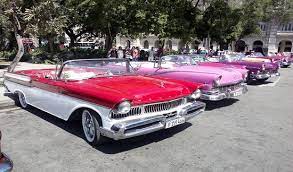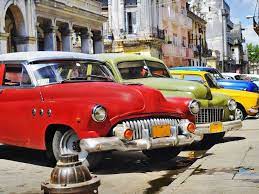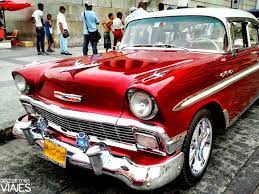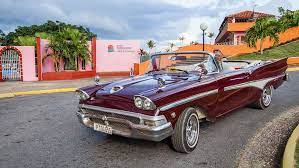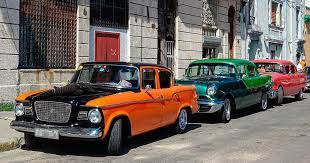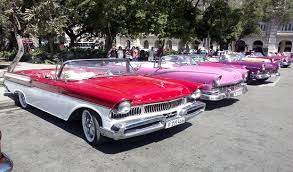LOS AUTOS CUBANOS (ALMENDRONES): MUSEO VIVIENTE DE CARROS CLÁSICOS. FOTOS.
A medida que viaja por el país, dondequiera que vaya verá autos clásicos en varios estados de reparación, desde relucientes Chevrolet con detalles cromados relucientes, hasta destartalados taxis Lada que están más oxidados que metal. Estar en Cuba es como caminar por las calles de un museo viviente del motor.
Se estima que hay entre 60 y 70 000 autos antiguos en Cuba, desde modelos estadounidenses clásicos como Chevrolets, Buicks, Chryslers, Oldsmobiles y Fords hasta Volgas y Ladas de la era soviética. Alrededor de la mitad de ellos datan de la década de 1950, el resto son aún más antiguos.
En los EE. UU. o el Reino Unido, estos autos serían artefactos históricos, guardados cuidadosamente en un garaje con temperatura controlada, cuidadosamente pulidos todas las semanas y conducidos solo en las ocasiones más especiales. Pero en Cuba son las correrías diarias de la gente, usadas como estandarte para recoger amigos o hacer mandados.
Cuando Ud llegue a La Habana y vea una fila de hermosos autos antiguos esperando afuera del aeropuerto, se te perdonará que pienses que volaste a otro país, sino tambien a otro siglo.
¿POR QUÉ HAY TANTOS AUTOS CLÁSICOS EN CUBA?
La historia de los autos de Cuba está indisolublemente ligada a la historia de Cuba misma.
Cuba no tiene una industria de fabricación de automóviles, por lo que durante la primera mitad del siglo XX, Estados Unidos fue el principal proveedor de automóviles a Cuba. Los cubanos amaban sus autos; de hecho, en un momento Cuba fue el principal importador de autos estadounidenses en toda América Latina.
En la década de 1950, el país estaba en auge. Con Miami a solo 90 millas de distancia, Cuba era un punto de acceso para los turistas estadounidenses y albergaba a celebridades como Frank Sinatra y Ernest Hemingway. Y donde tienes celebridades, necesitas autos lujosos.
En la década de 1950, se importaron a Cuba unos 125 000 autos, ahora clásicos, y para 1956 había más de 140 000 autos en las carreteras de Cuba.
Pero luego, en 1959, todo cambió. La revolución de Fidel Castro cortó las relaciones entre Estados Unidos y Cuba. Prohibió todas las importaciones de automóviles estadounidenses e introdujo leyes estrictas para los propietarios de automóviles cubanos.
Estados Unidos respondió con un embargo comercial que encerró a Cuba en una cápsula del tiempo durante más de medio siglo.
¿CÓMO SIGUEN FUNCIONANDO LOS AUTOS CUBANOS?
Sin forma de comprar autos nuevos o incluso obtener repuestos para los que ya tenían, los cubanos se vieron obligados a convertirse en mecánicos. Cuando los motores se desgastaron, encontraron formas de arreglarlos. Improvisaron y se adaptaron, utilizando la creatividad, el ingenio y la perseverancia para mantener sus autos en marcha.
Los vehículos se reparaban con piezas de otros, creando modelos ‘Frankenstein’. Para el ojo inexperto, puede parecer que están en las mejores condiciones, pero cualquier experto en automóviles pronto detectará la mezcla de componentes debajo del capó. Los autos cubanos son una especie propia.
Los cubanos trabajan duro para mantener sus autos antiguos en la carretera, los hoy llamados “almendrones”. Los coleccionistas de autos antiguos probablemente se quedarían boquiabiertos ante esto (en los círculos de autos clásicos se considera un sacrilegio mezclar y combinar modelos), pero a los cubanos no les importan esos detalles. Los autos siguen funcionando, y eso es todo lo que importa.
Aunque después de décadas de reparaciones y repintado, a veces puede ser un poco complicado identificar la marca y el modelo originales de estos autos híbridos.
AUTOS EN CUBA HOY
No fue hasta la década de los 90 que los cubanos realmente descubrieron el valor de la inversión que habían estado nutriendo cuidadosamente todo este tiempo. Pensaron que sus autos clásicos eran solo un medio práctico de transporte. Pero cuando el turismo comenzó a explotar, de repente se dieron cuenta de que también eran una gran atracción por derecho propio.
Oldsmobiles, Pontiac Star Chiefs, Chevrolets son algunos de los autos que circulan hoy en Cuba. Automóviles clásicos cubanos, incluidos Ford Fairlanes, Chevrolet Bel Airs y Plymouths, tambien vimos un automóvil de marca no identificada en Cienfuegos.
Hoy en día todavía hay alrededor de 60,000 a 70,000 autos clásicos en Cuba, la mayoría en La Habana, donde se deslizan majestuosamente por las coloridas calles o se sientan con orgullo frente a hermosos edificios ornamentados como brillantes joyas antiguas.
Lamentablemente para los fotógrafos, pero felizmente para el pueblo cubano, ya no son el único tipo de automóvil en Cuba. En 2016, Raúl Castro finalmente relajó las reglas sobre la propiedad de automóviles, y los automóviles nuevos y modernos de Europa y Asia han comenzado gradualmente a regresar a la isla.
Sin embargo, todavía son caros, están altamente regulados y están mucho más allá de los medios de la mayoría de los cubanos, por lo que todavía hay mucho espacio para que brillen los gloriosos autos cubanos antiguos.
¿PUEDES CONDUCIR LOS HAVANA CARS?
Es casi imposible ver una fila de estas bellezas estacionadas en una calle de La Habana, todas de colores vivos y relucientes accesorios cromados, y no querer dar una vuelta en uno de ellos.
La forma más fácil de hacerlo es reservar un recorrido por la ciudad. Por lo general, cuestan entre US$25 y US$30 por una hora, durante la cual podrá recorrer las calles de La Habana en uno de los autos cubanos más brillantes de todos, tal vez un Chevrolet descapotable o un Buick clásico, fingiendo que es un personaje de una novela de Ernest Hemingway.
Más barato, pero un poco menos glamoroso, es simplemente tomar un taxi. Muchos taxis cubanos son autos clásicos, por lo que casi cada vez que tome un taxi, estará viajando en un pedazo de historia. Sin embargo, estos son normalmente los golpeados y en mal estado, ya que cualquiera que posea un espécimen prístino lo usará para los recorridos elegantes mencionados anteriormente.
Desde 2019, es posible alquilar un automóvil clásico sin conductor, pero tenga cuidado. Esto es mucho más caro que el alquiler de coches normal y conducir en Cuba es bastante peliagudo. Si desea salir de la ciudad y hacer un viaje más largo como parte de su itinerario en Cuba, es mejor alquilar un automóvil y un conductor.
Recuerde también que estos autos antiguos no tienen cinturones de seguridad ni ninguna de las otras características de seguridad de los autos modernos. Entonces, si está planeando un viaje largo, le recomendamos encarecidamente que prefiera la practicidad al estilo y alquile un automóvil más moderno.
¿PUEDE COMPRAR UNO DE LOS AUTOS ANTIGUOS DE CUBA?
Estoy seguro de que hay miles de fanáticos de los autos clásicos que sueñan que solo con tener una tarjeta de turista cubana será suficiente para poder entrar, recoger todos los gloriosos autos cubanos y exportarlos a otros países. Afortunadamente para Cuba y su industria turística, eso es ilegal.
Solo los ciudadanos cubanos o los extranjeros con residencia permanente en el país pueden comprar un automóvil cubano, por lo que su sueño de recorrer las calles de su ciudad natal en un reluciente Plymouth o Pontiac tendrá que posponerse.
Por supuesto, eso es algo bueno, ya que significa que el museo de automóviles viviente de Cuba seguirá prosperando en los años venideros.
THE CUBAN CARS (ALMENDRONES): A LIVING CLASSIC CAR MUSEUM IN CUBA. PHOTOS
As you travel around the country, everywhere you go you’ll see classic cars in various states of repair, from glossy Chevrolets with gleaming chrome details waiting to take tourists on trips around Havana, to beaten-up Lada taxis that are more rust than metal. Being in Cuba is like walking the streets of a living motor museum.
There are an estimated 60-70,000 vintage cars in Cuba, from classic American models like Chevrolets, Buicks, Chryslers, Oldsmobiles, and Fords to Soviet-era Volgas and Ladas. About half of them date back to the 1950s, the rest are even older.
In the USA or UK, these cars would be historic artifacts, locked carefully in a temperature-controlled garage, lovingly buffed every week, and driven only on the most special occasions. But in Cuba, they are people’s daily runarounds, used as a standard for picking up friends or running errands.
When you first arrive in Havana and see a queue of beautiful vintage cars waiting outside the airport, you’ll be forgiven for thinking you didn’t just fly to another country, but to another century.
WHY ARE THERE SO MANY CLASSIC CARS IN CUBA?
The story of Cuba’s cars is inextricably linked to the history of Cuba itself.
Cuba has no car manufacturing industry, so for the first half of the 20th century, the USA was the main supplier of cars to Cuba. Cubans loved their cars – in fact, at one point Cuba was the top importer of American cars in the whole of Latin America.
By the 1950s, the country was booming. With Miami just 90 miles away, Cuba was a hotspot for American tourists, playing host to celebrities like Frank Sinatra and Ernest Hemingway. And where you have celebrities, you need fancy cars.
This Ford Fairlane is one of many Cuba vintage cars you may spot in Havana
In the 1950s an estimated 125,000 classic cars were imported to Cuba, and by 1956 there were over 140,000 cars on Cuba’s roads.
But then in 1959 everything changed. Fidel Castro’s revolution severed US-Cuban relations. He banned all American car imports and brought in strict laws on Cuban car owners.
The US responded by bringing in a trade embargo that effectively locked Cuba in a time capsule for over half a century.
HOW DO CUBAN CARS KEEP RUNNING?
With no way to buy new cars or even get spare parts for the ones they already had, Cubans were forced to become mechanics. When engines wore out, they found ways to fix them. They improvised and adapted, using creativity, ingenuity, and perseverance to keep their cars going.
Vehicles were repaired with parts from others, creating ‘Frankenstein’ models. To the inexperienced eye, they may look like they’re in top condition, but any car expert will soon spot the mishmash of components under the hood. Cuban cars are a species all of their own.
Cubans work hard to keep their vintage cars on the road. Vintage car collectors would probably gasp in horror at this – in classic car circles it’s considered sacrilegious to mix-and-match models – but Cubans don’t care about such details. The cars are still running, and that’s all that matters.
Though after decades of patchwork repairs and repainting, it can sometimes make identifying the original make and model of these hybrid cars a little tricky!
CARS IN CUBA TODAY
It wasn’t until the 90s that Cubans truly discovered the value of the investment they’d carefully been nurturing all this time. They thought their classic cars were just a practical means of transport. But when tourism started to explode, they suddenly realized they were also a major attraction in their own right.
Oldsmobile, Pontiac Star Chief, Chevrolet, and two Ford Fairlanes are some of the cars in Cuba today. Classic Cuban cars including a Ford Fairlane, Chevrolet Bel Air, and a Plymouth, an unidentified car in Cienfuegos.
Today there are still around 60-70,000 classic cars in Cuba, mostly in Havana, where they glide majestically through the colorful streets or sit proudly in front of gorgeous ornate buildings like bright vintage jewels.
Sadly for photographers, but happily for the Cuban people, they are no longer the only type of cars in Cuba. In 2016, Raul Castro finally relaxed the rules on car ownership, and new, modern cars from Europe and Asia have gradually started making their way back to the island.
However they are still expensive, highly regulated, and far beyond the means of most Cubans, so there is still plenty of space for the glorious vintage Cuban cars to shine.
CAN YOU DRIVE THE HAVANA CARS?
It’s almost impossible to see a row of these beauties parked on a Havana street, all vivid colors and gleaming chrome accessories, and not want to take one for a spin.
The easiest way to do this is to book a city tour. These usually cost about US$25-30 for an hour, during which you’ll get to cruise the streets of Havana in one of the most sparkling Cuban cars of all, perhaps an open-topped Chevrolet or classic Buick, pretending you’re a character in an Ernest Hemingway novel.
Cheaper, but slightly less glamorous, is simply to hail a taxi. Many Cuban taxis are classic cars, so almost any time you grab a cab you’ll be riding in a piece of history. These are normally the beaten up, shabby ones though, since anyone who owns a pristine specimen will be using it for the fancy tours mentioned above.
Since 2019 it’s become possible to rent a classic car for self-drive but be warned. This is much more expensive than regular car hire and driving in Cuba is quite hairy. If you want to leave the city and take a longer trip as part of your Cuba itinerary, it’s better to hire a car and driver.
Remember as well that these old cars have neither the seatbelts nor any of the other safety features of modern cars. So if you’re planning a long trip, you’re strongly advised to go for practicality over style and rent a more modern car.
CAN YOU BUY ONE OF THE CUBA OLD CARS?
I’m sure there are thousands of classic car fans who dream that just having a Cuban tourist card will be enough to allow them to swoop in, scoop up all the glorious Cuban cars, and export them to other countries. Fortunately for Cuba and its tourism industry, that’s illegal.
Only Cuban citizens or foreigners permanently resident in the country are allowed to buy a Cuban car, so your dream of cruising the streets of your hometown in a sparkling Plymouth or Pontiac will have to be put on hold.
Of course, that’s a good thing, since it means Cuba’s living car museum will continue to thrive for years to come.
Agencies/ Wiki/ Passport&Pixels/ CubanCars/ Extractos/ Excerpts/ Internet Photos/ Arnoldo Varona/ www.TheCubanHistory.com
THE CUBAN HISTORY, HOLLYWOOD.



 LOS AUTOS CUBANOS (Almendrones): Museo Viviente de Carros Clásicos. PHOTOS. * THE CUBAN CARS (Almendrones): A Living Classic Car Museum in Cuba. PHOTOS.
LOS AUTOS CUBANOS (Almendrones): Museo Viviente de Carros Clásicos. PHOTOS. * THE CUBAN CARS (Almendrones): A Living Classic Car Museum in Cuba. PHOTOS.